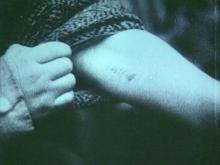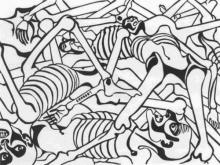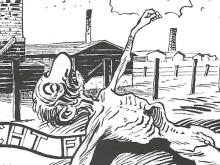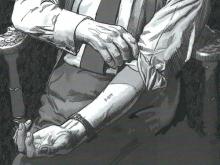X-Men
X-MEN, Bryan Singer, USA 2000
The first film in the franchise X-MEN opens in 2000 with a sequence that is set in the 1940s in a German concentration camp in Poland. Expecting to see a film about mutants with superpowers, viewers are instead witnessing a series of iconic shots known from films about the Holocaust: watchtowers, muddy ground, barbed wire, slave labor, as well as typical sounds such as barking dogs and shouting. The setting reveals an iconic situation known from many Holocaust testimonies: the separation of families during the selection. People are marked with Yellow Stars that indicate that they are Jews.
The main protagonist of the scene is a boy, and the viewers experience the scene through his eyes. The typical shaking camera and the point-of-view shots indicate the perspective of a witness. The boy sees more iconic signs, among them the number tattooed on the arm of a female prisoner. Like the other iconic images, the number functions as a symbol conveying the specific context to the audience. With the help of these shots, the Holocaust is established as a background for the main storyline focusing on the struggle of mutants for social acceptance and against discrimination and humiliation. It turns out that the young boy is Magneto, a Holocaust survivor and one of the main protagonists of the film series that is based on comic books created by Jack Kirby and Stan Lee. Originally the two Jewish American comic artists intended the stories to reflect the situation of the Afro-American civil rights movement in the 1960s. Magneto and his friend/opponent Professor Xavier symbolised Malcolm X and Martin Luther King as representatives of two diverging concepts: separation vs. equality. Only in the 1980s did Magneto transform into a Holocaust survivor, now closely aligning his experience of loss and exclusion to the Jewish trauma of surviving the Holocaust.
The film version of the X-Men emphasises this dimension even further. The Number Tattoo plays an important role in this (visual) discourse. The first movie refers to it several times. The Number Tattoo is also a visual reference in several of the sequels and prequels, used for symbolising the perspective and experience of Magneto as a survivor. In doing so, the films do not only adopt the specific visual pattern from the original footage - the close-up - but also its context as a symbol of survival. In the third movie THE LAST STAND (2006), director Brett Ratner also emphasises the particular gesture of demonstratively showing the number when Magneto confronts a young generation of mutants with his mark. Furthermore, the specific plot of X-MEN also connects to another contextualising element of the original footage by introducing Magneto as a victim of “medical” experiments conducted in the camp by the German Nazi-doctor Sebastian Shaw alias Klaus Schmidt. This demonstrates that the Number Tattoo and other iconic images are not just superficial gimmicks adapted to the visual setting of the X-MEN movies but a contextualising element that connects the tale of the mutants fighting discrimination with the experiences of the Holocaust.





